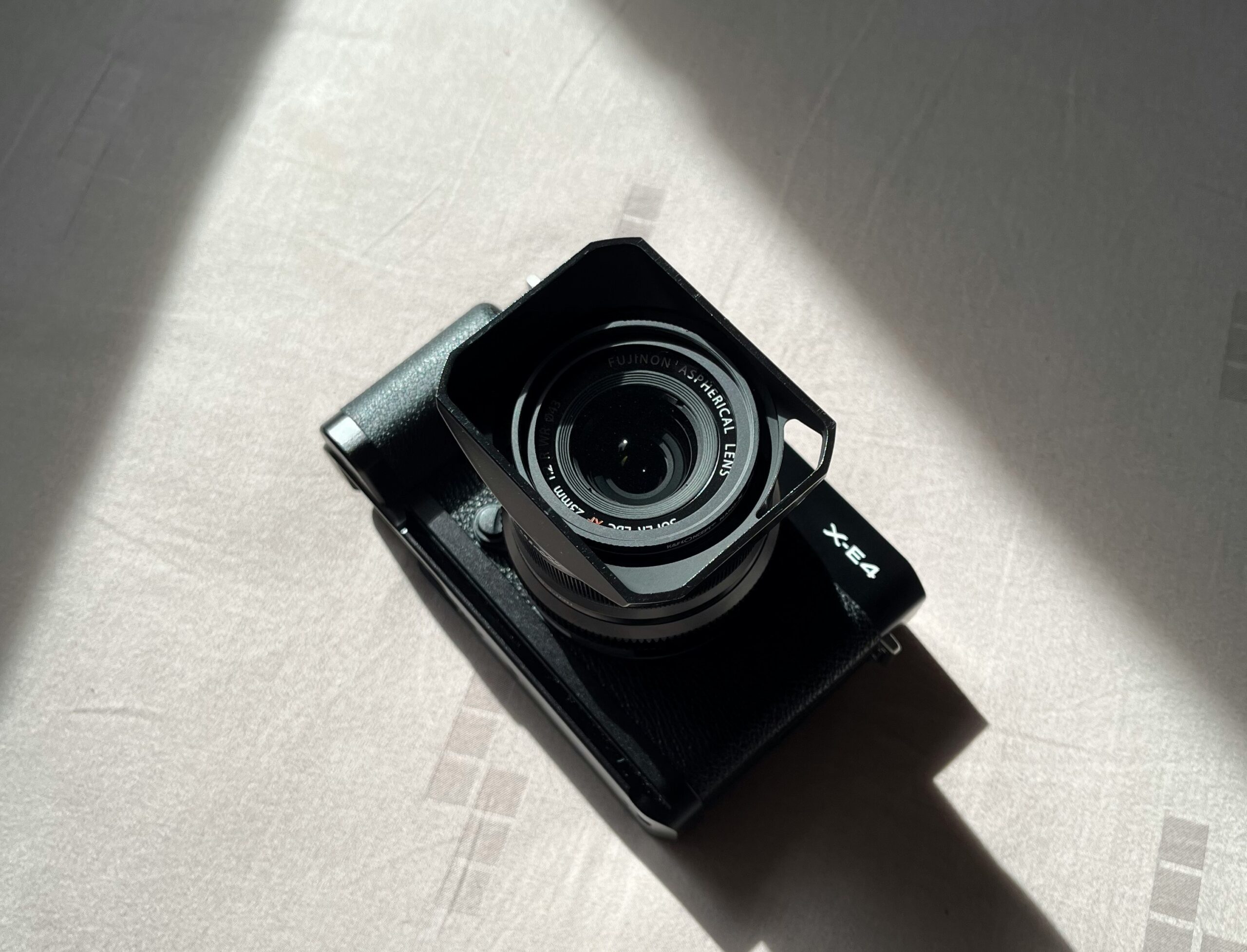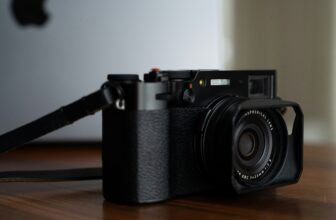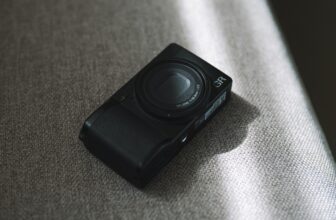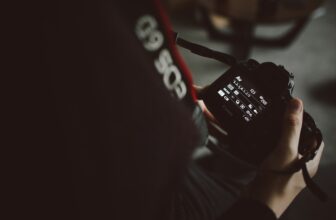Fuji XE4 vs X100V: Exploring the Key Differences

This post contains affiliate links which means I may receive a commission from purchases made through links. I will only recommend products I know personally used, and can attest to their high quality. Learn more on my private policy page
The Fujifilm X100V has built a name for itself in the street photography scene. However, this overlooks the fact that there are perfectly viable competitors to the Fujifilm X100V. To help you make the best decision for photography and choose the right camera, be sure to consider more options than just the classic X100V. The Fujifilm XE4 is also a perfectly viable option for street photography.
Pros of the Fujifilm XE4
- The X-E4 is a compact and lightweight camera.
- The X-E4 is equipped with a vari-angle touchscreen, which can be tilted and swiveled for flexible shooting angles.
- Grip: The XE4’s grip is a lot more secure.
| Pros | Fujifilm XE4 |
|---|---|
| Compact and Lightweight | The X-E4 is a compact and lightweight camera. It’s a great option for those that value portability. It’s small and easy to carry around. For travel its also a good option. |
| Excellent Image Quality | Fujifilm cameras are known for their outstanding image quality, and the X-E4 is no exception. It features a 26.1-megapixel APS-C X-Trans CMOS 4 sensor, which produces high-resolution and sharp images with excellent color rendition. |
| Vari-Angle Touchscreen | The X-E4 is equipped with a vari-angle touchscreen, which can be tilted and swiveled for flexible shooting angles. This feature is beneficial for vloggers, selfie enthusiasts, and those who want creative composition options. |
Design and Form Factor
The XE4 has a more comfortable grip which means you can hold the camera more securely. It has more customizeable buttons and adjusting everything is quicker and more intuitive.
The shutter dial only has the shutter speeds, and not the ISO. The unique part about the Fujifilm X100v is that it also has the ability to change the ISO in the same dial.
The X100v has a less pronounced grip, so its a lot less comfortable during longer hours of shooting. The controls allow for easier adjustments on the fly. The X100V took the retro look as priority over a comfortable grip.
What makes both of these cameras unique is the feeling of control that they provide you. A lot of the feel of these cameras is similar to the way you use a film camera. So, both cameras are great for someone who wants to shoot digital with the feel of film.
The X100v gives you more of that feel and look because the dials are not only customizeable, but you can change both shutter speed and ISO with the same dial. The aperture ring makes it easy to switch to different apertures on the fly.
The X100v has a better viewfinder overall because you can switch from electronic to optical and use whichever suits you best. It’s also much clearer than the XE4. The XE4’s viewfinder is a bit small and doesn’t give you the feeling of control over what you’re doing.
If you prefer to use the back LCD then both cameras are the same and there is nothing different about this. The XE4 gives you more freedom to move the LCD screen around, but I find this pretty useless unless you really crave taking selfies.
The X100v has a leaf shutter which is my favorite part of the camera. One thing that is incredibly overlooked is how important it is to have a quiet shutter, something very under the radar that won’t draw attention to yourself.
If you’re shooting street photography the last thing you want is all eyes on you when you’re taking photos because it comes out in the photo. Sometimes, this can ruin the entire composition you’re going over if you go in guns blazing firing away with a loud DSLR. a compact quiet camera can help you get the shot without disturbing the scene.
Image Quality and Sensor Performance Comparison
| Camera | Resolution | Sensor Type | Low-Pass Filter | Dynamic Range |
|---|---|---|---|---|
| Fuji XE4 | 26MP | Bayer CMOS | Yes | 13 stops |
| Fuji X100V | 26.1MP | X-Trans CMOS 4 | No | 13.5 stops |
Autofocus and Performance
The autofocus system is an essential feature of any modern camera. When it comes to the Fuji XE4 and X100V, both cameras offer impressive AF capabilities, but there are some notable differences.
The Fuji XE4 features a hybrid AF system, combining both phase and contrast detection for fast and accurate autofocus. With 425 AF points covering nearly the entire sensor, you can be sure to capture even the tiniest details with ease. The camera offers advanced face and eye detection, a feature highly sought after by portrait photographers.
The X100V, on the other hand, features a 425-point hybrid AF system with phase detection pixels covering approximately 99% of the sensor area. Its improved AF algorithm allows for faster and more accurate focus acquisition, making it a great choice for street and travel photography.
In terms of performance, both cameras offer quick and precise AF in good lighting conditions, but their performance can suffer in low light. However, the X100V performs slightly better with its new Low Light Priority AF mode, which allows for faster and more accurate AF even in challenging lighting situations.
To sum up, both the XE4 and X100V offer reliable and fast autofocus systems, but the X100V has the edge with its improved AF algorithm and Low Light Priority mode.
Lens Options and Versatility
When it comes to lenses, the Fuji XE4 and X100V offer different options and focal lengths.
The XE4 is compatible with Fujifilm’s X-mount lenses, which allows for a wide range of options, from ultra-wide angle to telephoto. With over 30 lenses available, you can choose the one that best suits your needs and shooting style. Additionally, third-party lens manufacturers also offer options, expanding your lens choices even further.
The X100V, on the other hand, features a built-in fixed lens with a 23mm focal length, which is roughly equivalent to a 35mm lens on a full-frame camera. This fixed lens system provides a compact, lightweight camera and a fast aperture of f/2, which is ideal for low-light situations and creating a shallow depth of field. However, the downside is that you cannot change the lens, limiting your shooting capabilities.
Overall, the XE4 offers greater versatility with its interchangeable lenses, while the X100V provides a more compact option with a fast prime lens.
Viewfinder and Display
Fuji XE4
The Fuji XE4 features an electronic viewfinder (EVF) with a 2.36 million dot resolution, providing clear and detailed image previews. It also has a 3.0-inch rear LCD screen with a resolution of 1.62 million dots that can tilt up and down, allowing for flexible shooting angles. The touchscreen functionality on the LCD screen is a welcome addition, making it quick and easy to select your focus point or navigate menu options.
Fuji X100V
The Fuji X100V also has an EVF, but with a higher resolution of 3.69 million dots, providing an even more detailed and immersive shooting experience. The 3.0-inch LCD screen is also similar to that of the XE4, with a resolution of 1.62 million dots and tilting capability. However, it also features a unique and innovative flip-down design that allows for shooting at low angles, perfect for street photography or candid shots.
Comparison
| Camera | Viewfinder | LCD Screen |
|---|---|---|
| Fuji XE4 | 2.36 million dot resolution EVF | 3.0-inch 1.62 million dot resolution LCD screen with touch functionality and tilt capability |
| Fuji X100V | 3.69 million dot resolution EVF | 3.0-inch 1.62 million dot resolution LCD screen with flip-down design and tilt capability |
Overall, both cameras offer impressive viewfinder and display options that can enhance your photography and videography experience. The X100V’s higher resolution EVF may be advantageous for more detailed and accurate composition, while the XE4’s touchscreen functionality is excellent for quick and intuitive navigation of the camera’s settings and focus points. The X100V’s flip-down LCD screen is also a unique feature that can expand your shooting possibilities. Evaluate which features are most important to you to determine which camera is the better fit for your needs.
Connectivity and Accessories
When it comes to connectivity, both the Fuji XE4 and X100V are equipped with the latest wireless technologies, including Wi-Fi and Bluetooth. These features allow you to easily transfer your images to your smartphone or tablet, making it simple to share your creations on social media or other online platforms.
The Fuji XE4 also includes a USB Type-C port, providing faster transfer speeds and charging times compared to the X100V’s USB Type-A port.
Both cameras have the ability to connect to an external flash unit or remote trigger, providing you with more flexibility and creative control. However, it’s worth noting that the X100V has a built-in ND (neutral-density) filter, which can be a valuable tool for video and long-exposure photographers.
Overall, the connectivity and accessory options for both cameras are quite comprehensive, providing you with the tools to take your photography to the next level.
Fuji XE4 vs X100V Price Comparison
To give you an idea of the price differences between the two models, we have compiled a table below:
Note: The prices listed above are subject to change and may vary based on individual retailers and promotions available at the time of purchase.
As you can see, the Fuji XE4 is generally more affordable than the X100V, making it a great pick for photographers on a budget. However, it is worth noting that the X100V offers additional features such as a built-in lens and hybrid viewfinder, which may justify the extra cost for some photographers.
When considering the value for money, it is crucial to weigh the benefits of each camera against their prices. If you require a camera with exceptional image quality and autofocus performance, the X100V may be the more valuable choice. However, if you prefer to have greater versatility in lens options and connectivity features, the XE4 could provide more value for your money.
User Interface and Controls
The user interface and controls of the Fuji XE4 and X100V cameras play a crucial role in how intuitive and efficient they are to operate. The menu systems, physical controls, and customizable options can affect the overall user experience.
The Fuji XE4 camera features an updated user interface that is easy to navigate. The top-plate dials and buttons have been repositioned for better accessibility. The camera is lightweight and compact, making it a good option for street and travel photography. The XE4’s customizable options include six function buttons that you can assign to your preferred shooting settings, allowing you to quickly change settings on the fly.
The Fuji X100V, on the other hand, features a hybrid viewfinder that combines an optical and electronic viewfinder. The controls resemble those of a classic film camera, with aperture and shutter speed controls located on the lens barrel. The X100V also has six customizable function buttons, allowing you to quickly access frequently used settings.
The Menu System
The menu system of the Fuji XE4 and X100V is clear and easy to navigate. Both cameras feature a quick menu that can be accessed by pressing the Q button. The quick menu allows you to adjust frequently used settings like ISO, white balance, and film simulation mode. You can also customize the quick menu to include your preferred settings.
The X100V also includes a my menu feature that allows you to create a custom menu with your frequently used settings. This can be a handy feature for users who prefer to have quick access to specific settings.
Physical Controls
The physical controls of the Fuji XE4 and X100V are well-designed and easy to use. Both cameras feature top-plate dials for adjusting aperture, shutter speed, and exposure compensation. The X100V has additional controls on the lens barrel for adjusting aperture and shutter speed.
The XE4 has a joystick that can be used for selecting focus points, navigating menus, and reviewing images. The X100V features a focus lever that can be used for selecting focus points and navigating menus.
Customizable Options
Both the Fuji XE4 and X100V offer customizable options, allowing you to tailor the camera to your shooting style. The XE4 features six customizable function buttons that you can assign to your preferred settings. The X100V also has six customizable function buttons, as well as a my menu feature for creating a custom menu with frequently used settings.
Overall, the Fuji XE4 and X100V have well-designed user interfaces and controls. The XE4 is a good option for photographers who prefer a lightweight and compact camera, while the X100V’s hybrid viewfinder and classic film camera controls may appeal to those who want a more unique shooting experience.
Battery Life and Storage Options
Long photography sessions or trips require sufficient battery life and storage space. Let’s take a closer look at the battery performance and storage options available on the Fuji XE4 and X100V cameras.
Battery Life
The Fuji XE4 is equipped with a rechargeable NP-W126S Li-ion battery pack, which provides a battery life of approximately 460 shots per charge. Meanwhile, the Fuji X100V is powered by a rechargeable NP-W126S Li-ion battery, which delivers a battery life of up to 350 shots per charge. However, both cameras offer an optional battery grip, which can increase the battery life by about 1.5 times for extended shooting sessions.
Storage Options
The Fuji XE4 and X100V both support SD, SDHC, and SDXC memory cards, with UHS-I and UHS-II compatibility for faster read and write speeds. However, the X100V also offers internal memory storage of approximately 20MB, which can act as a backup or temporary storage option for small file sizes. Additionally, the X100V has a USB Type-C port that supports external storage via an adapter.
| Battery Life | Storage Options | |
|---|---|---|
| Fuji XE4 | Approximately 460 shots per charge | SD, SDHC, and SDXC memory cards with UHS-I and UHS-II compatibility |
| Fuji X100V | Up to 350 shots per charge (with optional battery grip for extended battery life) | SD, SDHC, and SDXC memory cards with UHS-I and UHS-II compatibility, internal memory storage of approximately 20MB, and USB Type-C port for external storage (with adapter) |
Overall, when it comes to battery life and storage options, the Fuji XE4 and X100V offer similar capabilities, with optional battery grips and SD card compatibility for extended shooting and storage needs. Always carry extra batteries and memory cards to avoid running out of power or storage space mid-shoot.
FAQ
What are the key differences between the Fuji XE4 and X100V?
The Fuji XE4 and X100V differ in terms of design, form factor, image quality, autofocus performance, lens options, viewfinder, display, video capabilities, connectivity, price, user interface, battery life, and storage options.
How does the design and form factor of the Fuji XE4 and X100V compare?
The Fuji XE4 and X100V have different sizes, weights, and handling characteristics. We will explore their design and form factors in detail to help you understand how they feel and operate in real-world shooting situations.
What is the image quality and sensor performance like on the Fuji XE4 and X100V?
The image sensors of the Fuji XE4 and X100V play a crucial role in determining image quality. We will compare their resolution, dynamic range, low-light capabilities, and overall image quality to assess their performance in this aspect.
How does the autofocus performance of the Fuji XE4 and X100V differ?
The autofocus systems of the Fuji XE4 and X100V vary in terms of speed and accuracy. We will analyze their performance in different shooting scenarios, such as fast-moving subjects or low-light conditions, to help you understand which camera excels in this aspect.
What are the lens options and versatility of the Fuji XE4 and X100V?
The Fuji XE4 and X100V offer different lens systems, impacting their versatility. We will discuss their focal lengths, aperture ranges, and overall shooting capabilities to help you determine which camera suits your specific needs.
How do the viewfinder and display of the Fuji XE4 and X100V compare?
The electronic viewfinders and LCD screens on the Fuji XE4 and X100V differ in terms of resolution, size, and usability. We will compare and evaluate these features to help you choose the camera that provides the best viewing experience.
What is the video performance like on the Fuji XE4 and X100V?
Both the Fuji XE4 and X100V offer video recording capabilities. We will examine their resolution options, frame rates, video quality, and additional features relevant to filmmaking or vlogging to determine their video performance.
What connectivity options and accessories are available for the Fuji XE4 and X100V?
The Fuji XE4 and X100V offer various connectivity features, such as Wi-Fi, Bluetooth, and USB ports. We will also discuss their compatibility with accessories like external flash units or remote triggers to enhance your shooting experience.
How do the prices of the Fuji XE4 and X100V compare?
We will compare the prices of the Fuji XE4 and X100V to help you evaluate their value for money based on their features, performance, and overall package. This section will assist you in making a budget-conscious decision.
What is the user interface and control experience like on the Fuji XE4 and X100V?
The menu systems, physical controls, and customizable options differ between the Fuji XE4 and X100V. We will assess their user interfaces and controls to determine the camera that offers an intuitive and efficient shooting experience for you.
How is the battery life and storage options on the Fuji XE4 and X100V?
Battery life and storage capacity are crucial considerations for extended shooting sessions. We will explore the battery performance and storage options available on the Fuji XE4 and X100V to ensure they meet your power and storage requirements.
Which camera, Fuji XE4 or X100V, is the best fit for my needs?
In the conclusion section, we will summarize the key differences and similarities between the Fuji XE4 and X100V. Based on the information presented throughout the article, you will be able to make an informed decision about which camera is the best fit for your photography style, budget, and specific requirements.
This post contains affiliate links which means I may receive a commission from purchases made through links. I will only recommend products I know personally used, and can attest to their high quality. Learn more on my private policy page






